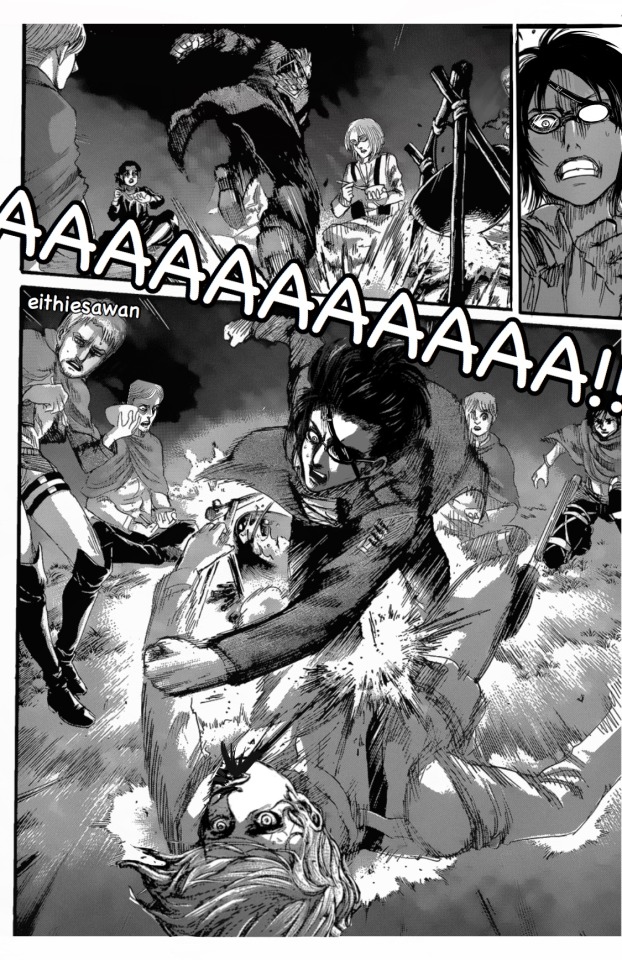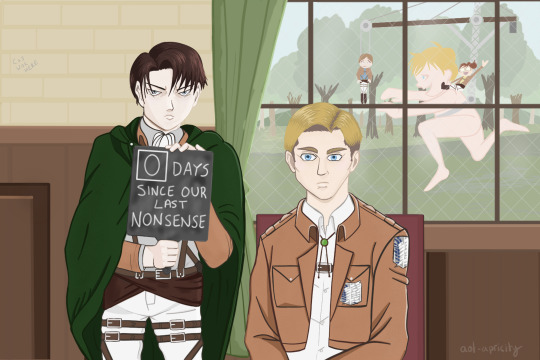#sawney and bean
Explore tagged Tumblr posts
Text

Here we have rock deity, Hange Zoe, the ultimate Monarch of Maestros.

And here we have two of their biggest fans.
15 notes
·
View notes
Text



#aot#titans aot#attack on titan junior high#snk#shingeki no kyojin#cute#perring titan is cute#attack on titan#Sawney and Bean
13 notes
·
View notes
Text
why’ve i searched up sawney and bean (titans in aot) and a mfing CANNIBAL has come up😭😭
IS TJAT WHAT THEYRE NAMED AFTER?!
#aotisthebestthingtogracethisplanet#aot#attack on titan#sawney bean#sawney and bean#hange zoe#hange u odd bugger…
9 notes
·
View notes
Text




the fact that this is an actual story tho and not something isayama made up
45 notes
·
View notes
Text
Never knew til now that I would need that closure for Sawney and Bean 😅
I wonder how that confession would play out between Annie and Hange, it would trigger a reaction from Hange for sure (though hopefully not so violent but probably just as scary, heh).



So I was wondering how would Hange react if she knew
And I Oop- came out with this shit :)
#hange zöe#hange zoe#annie leonhart#sawney and bean#shingeki no kyojin#attack on titan#aot#aot fanart
2K notes
·
View notes
Text
Who wants to be the Sawney to my Bean? 😭
1 note
·
View note
Text


9 notes
·
View notes
Text
Annie + Hitch from AOT Stamps!
for me and my dad @perr1e + matching beane and sawney stamps!









#aot#attack on titan#web resources#graphics#page decor#stamp collection#stamp#web graphics#sawney bean
11 notes
·
View notes
Text

Today an inspector from the government paid a surprise visit to the Survey Corps base to assess how they were utilising their funding. Unfortunately, Section Commander Hange chose today of all days to test out their innovative, ingenious, PERFECTLY SAFE titan bait mechanism (do not question the physics). According to Captain Levi Ackerman, Commander Erwin Smith is at risk of an aneurysm, while Hange's subordinate Moblit Berner is considering early retirement if he survives the afternoon.
#attack on titan#aot#aot fanart#levi ackerman#erwin smith#hange zoe#moblit berner#eruri#mobuhan#my art#snk#shingeki no kyojin#aot vets#survey corps#our last nonsense#the office#attack on titan memes#sawney and beane#aot-apricity
114 notes
·
View notes
Text
Levi would never disrespect a tea cup so much by hurtling it at someone’s head.
By by god he’s come this fucking close and some of these bratty scouts are really begging for it -
#he’s simultaneously talking about Sasha for ruining the pristine mathematics he did rationing food out#Conny for breaking his good broom while fucking about with Jean#Jean himself for leaving his uniform strewn about#Eren for Being Eren™️#Hange is on thin ice but luckily they’ve calmed down on the whole let’s-find-a-new-sawney-and-bean thing#mikasa he actually doesn’t mind at the moment#Armin is well behaved and tidy so he gets bonus points#he would love Marco if Marco were still here#everyone else is mid#attack on titan#shingeki no kyojin#levi ackerman#shit posting#aot memes#aot meme
19 notes
·
View notes
Text
Do I really need to plan another horror romance series with a CoD bastard? No. Am I thinking about it anyway? Unfortunately yes.
9 notes
·
View notes
Text
another thing about 126 is that if the point of concern for hansi here were actually him i think they would be behaving and speaking completely differently. all of their dialog is pretty much exclusively self-soothing. if anything they come off slightly tired and annoyed about the ackermann thing. we know what hansi looks like when someone or something they have a strong attachment to is hurt or in danger and it is not this
0 notes
Text
FOURTEEN
The Stinchar, descending from its interior heights, winds through a vale of which the scenery is, in my mind, unequalled, in wild beauty, by anything else in Scotland; and falls at last into the sea at Ballantrae.
ROBERT HERON, A Topographical Description of Scotland (1797)
AS OUR BUS rattles up the road that hugs the western sea, a large vehicle with four laughing men in it whistles past us towards Kennedy’s Pass, fishing rods sticking out of a side window like aerials. They may well just be off the Irish boat.
Fanning its tail behind it like a hand of cards, a kestrel floats on the breeze above the raised beach of Ballantrae and rides the sky beyond one of the oldest industrial buildings in Scotland, a windmill built in 1696. The weather here on the south Ayrshire coast has downgraded itself from unsettled to changeable and six stolid cows gather at a gate, clearly expecting rain more than the Met Office does.
A madcap aristocrat used to fly a biplane on the breezes here. In March 1928 Time magazine wrote of the daughter of Viscount Inchcape, head of P & O Ferries:
‘Dark, not unattractive, graceful, habitually well-gowned and bejeweled, Miss Mackay was the envy of most women. Her silver Rolls-Royce flashed by at breakneck speed. Her horses invariably galloped.’
Elsie Mackay was born in colonial India and was bred on the family estate at Glenapp castle, a mile and a half south of Ballantrae (the castle is reportedly where Churchill and Eisenhower planned D Day). In 1917 she eloped with Denis Wyndham, a South African actor, and after the war she became the silent screen actress Poppy Wyndham. The marriage lasted five years, whereupon she was welcomed back into the family fold. Her father prayed she would buckle down to the cushy life of an aristocrat, but she gained her pilot’s licence in 1923 and, five years later, she made off with a one-eyed war hero, Capt. Walter G. R. Hinchcliffe, to fly across the Atlantic against the prevailing winds. They took off from snowbound Cranwell aerodrome in England, but they were never seen again beyond the Irish coast. A crowd of 5,000 stood all night at Long Island, New York, waiting for them, but they never landed. Only a slither of debris was ever found. While they were missing, the New York Times stated: ‘Every luxury money commands has not satisfied Lord Inchcape’s daughter in her thirst for adventure.’


Time reported three months later: ‘Since the death of Elsie Mackay is now presumed, her father, mother, brother and sisters presented her residual estate of £500,000 to the British Exchequer, last week, announcing that they ‘have no desire to profit from her death’.’
Shrubs were planted in Glenapp, so that the name Elsie could be read from the sky. Nature has erased her name, but she is commemorated in a stained-glass window in the chancel of the church at Ballantrae. There is the inevitable ghost story. There are some who claim the steel-nerved socialite haunts the corridors of Glenapp Castle. The industrialist James Hunter built the castle as his home on ground he had purchased from the Earl of Orkney. It passed to the wealthy Mackays in 1917. In 2015 the castle was acquired by Paul and Poppy Szkiler. Paul is the Chairman of the Truestone Group. They have upgraded it into a luxury hotel.


As if to pay homage to the late aviatrix, the Monte Carlo rally passed through Ballantrae in 1961. It was the one and only time: the fact that an over-zealous policeman charged 10 drivers with speeding may have had something to do with that.
Nowadays visitors to the hotel can sail up and down the rugged coast accompanied by the resident falconers and Ripley, the resident sea eagle.
Fishing and farming fed the villagers of Ballantrae for generations, as did wholesale smuggling, and Robert Burns met many local smugglers when he was a boy in Ayrshire; he wrote to Dr John Moore, of Mauchline, of the smugglers’ ‘swaggering riot and roaring dissipation’. In his History of the Counties of Ayr and Wigtown (1863) James Paterson tells us boats with 30 guns had once landed their cargoes in Ballantrae, while a hundred ‘lintowers’, some of them armed with cutlass and pistol, conveyed the goods ‘by unfrequented paths through the country and even to Glasgow and Edinburgh’. Cellars were dug in kitchen floors along the coast and there were holes and caves stuffed with contraband. There is an apocryphal story that a farmer’s wife made porridge with brandy one morning and only realised her mistake when there was a noisy demand for seconds.


Ballantrae, whose original name was Kirkcudbright-inner-Tig, is a now a one-horse town along the A77, albeit with a sand and shingle beach and hulking dark rocks haunted by terns, sandpipers, cormorants and kittiwakes. The laybys here attract twitchers in quest of rare birds. Porpoises, grey seals and basking sharks pop up too now and then, but they are hiding today.
I’d a nap in a layby along this bracing shoreline after watching shags shimmying across sea-sculpted stones; I woke to a seabird symphony, and the daybreak splendour of the islet of Ailsa Craig surfacing from the water. Alas, I hadn’t dandered ten yards along the foreshore before I stood on a blackened heap of empty pop cans, wet wipes, polystyrene receptacles, half-consumed packets of a snack called Ringos, and what looked suspiciously like a condom. Who would defile this splendid coastline? What bampottery drives you to set fire to lemonade tins? And what would Elizabeth Anderson Gray have made of it all? It was along these picturesque shores that this local heroine spent her whole life collecting and classifying fossils. By the time of her death in 1925 she had extensive collections in several British museums.
Think The Wrong Turn meets The Texas Chainsaw Massacre meets The Silence of the Lambs and you’re getting close to the tale of Sawney Bean, who, tourism marketeers have long informed us, lived in a cave north of Ballantrae; that he was the head of a family of mutant monsters who waylaid travellers, robbed and murdered them, and then ate the evidence. There are tales of caves full of pickled and salted arms, legs, and other human body parts. Reportedly the male fiends were finally dismembered in front of the women, then the women and girls were burnt in a bonfire, but there is no historical record. There is a theory that the arch-Unionist and English spy, Daniel Defoe, put the story out to disparage Scotland.
An anonymous contributor to the online history group Ayrshire Notes observed in 2002: ‘The story cannot be traced beyond the 18th-Century equivalent of the Sunday Sport, so is it worth pursuing at all? I can think of no sound reason for doing so other than gratuitous and morbid titillation. What is most reprehensible about all this is that the myth is popularized as part of a despicable conspiracy of the heritage industry, tourist agencies and local authorities to turn parts of Scotland into little more than gruesome theme parks. If peddling the Sawney Bean story attracts tourists to Carrick, surely, they are the wrong kind of tourists.’
Ouch!

There is a long history of tramps, misfits, and disillusioned loners giving two fingers to the rat race to reinvent themselves, to become hermits; and several have found their havens in caves along Scottish shores. For 30 years, for example, Henry Ewing Torbet lived the quiet, simple life of a troglodyte in Bennane Cave, which is a stone’s throw from the one associated with the Beans. He was tall, straight-backed, with a long black beard and shaggy eyebrows – a colourful character, so well-liked that the locals put up a small cairn above his beloved shore as a memorial to him when he died of pneumonia after freak weather in 1983. He’d been a refugee from banking (and marriage), who had drifted around Scotland, and been in and out of jail for begging, at one time throwing a bag of flour and two bars of soap at a shopkeeper who had refused to serve him when he did not have ration coupons. At Ballantrae he was treated kindly, although he never spoke much. He lived on rabbits and potatoes, built fires from driftwood, and did odd jobs, although, in his Travels in Galloway, Memoirs of South-west Scotland, Donald McIntosh tells us: ‘He was as cunning as a hill fox and the very mention of the word work was enough to make him physically ill.’
McIntosh had heard that Torbet, who called himself Snib Scott, was offered soup and scones for chopping firewood. He had told the housewife: ‘Missus, when a man’s belly is empty, he doesnae have the strength to work.’ Two plates of broth and 10 cheese scones later, he got up and made off, remarking with a belch: ‘Missus, when a man’s belly is fu, he doesnae need to work.’
It is said that, after trudging across the hills of Glenapp into Galloway, he tried to cadge from a young farmer at Newton Stewart. The farmer and his friends washed, scrubbed, shaved, suited and booted Snib, and plied him with food and whisky. They took this clean-shaven, well-dressed gentleman to the young farmers’ ball and introduced him as a wealthy visiting farmer; and many ladies swarmed about him. The day after the night before, the joke was on the farmer; Snib was off on his wanderings again with four bottles of Johnnie Walker whisky crammed into his haversack.

In a layby down from Snib’s cave stands a monument to the former Russian Imperial Navy cruiser Varyag, which ran aground while being towed near Lendalfoot for scrap in 1920. The first memorial to the crew, who had years previously defied a Japanese siege, was unveiled in 2006 in a ceremony attended by Russian top brass. A year later a bronze monument was added. I’m told the then harbour master fell foul of Westminster for unilaterally inviting the Russian visitors.
Over the centuries travellers have reported screams around Lendalfoot, none of which was ever caused by birds. The ruins of Carleton Castle are reportedly haunted by John Cathcart, a Scottish Bluebeard, and by the eight heiresses he flung from the cliffs in order to augment his estate. His ninth chosen bride and victim, Mary Kennedy of Culzean, escaped by preemptively propelling him down to the rocks below.
#ayrshire#carrick#elsie mackay#glenapp castle#ballantrae#smuggler#ailsa Craig#sawney bean#cave dweller#varyag
0 notes
Text
Hallowe’en 2023
artwork by phil burns Click here to hear the poet read his words: Hallowe’enaw Scotland’s scary myths and legendsfae Tam o Shanter tae Sawney Beancreep and slither yince mair fae the shadowseach year the nicht o Hallowe’en(interlude)nae bairn can contain their excitementas the end of October draws neareach wee brain fair itchesas they think about witchesit is the scariest night of the year aye…

View On WordPress
#bogeyman#ghosts#ghouls#guising#Hallowe&039;en#poem#Poetry#pumpkin#sawney bean#tam o&039; shanter#treacle scones#trick or treat#turnip
0 notes
Text
I based This on a horror Story from Scotland but I tried to make It funny.
Sawney Bean : Tales to be Told
youtube
#Sawney Bean#scotland#scottish#youtube#horror#horror story#renaissance art#renaissance#john smith#king james bible#king james version
0 notes
Text
Idea for a “Dark Pictures Anthology” future installment:
1) TITLE
The Dark Pictures Anthology Presents: The Ortolan Songbird
2) PROLOGUE
1616, Scotland. A merchant named Callum McDonald and his wife, Shirley McDonald, are on their way to the town of Girvan when their wagon breaks down. As Callum attempts to repair the wagon, the couple are approached by a strange man who offers to help them out.
When Callum asks for the man’s name, the man says his name is Alexander “Sawney” Bean.
At some point, Sawney invites Callum and Shirley to spend the night at his clan’s home in Bennane Head. The couple agrees and follows Sawney back to his clan…where they are ambushed, killed, and cannibalized by Sawney and his entire family.
3) MAIN STORY
Present day, Edinburgh, Scotland. Famous American horror author Matthew Chen and his wife, Gale Chen, are visiting Scotland for vacation. The couple meets with their friends who live in Scotland; the reckless partygoer Samuel Campbell and the popular social media influencer Quinn Anderson. Together, the four decide that the first thing they should do for fun is eat dinner at “The Hairy Tree”, a restaurant in Edinburgh that has earned 3 Michelin stars.
Separate from this group of friends is private investigator Fiona Henderson. She is hired by a family to find their daughter Mary, who went missing several months ago. Despite the fact she had very little clues to work with, Fiona gets a break in the case that leads her to The Hairy Tree.
At The Hairy Tree, the special dish being served that night is the infamous Ortolan songbird. A dish so heinous that, according to French tradition, the eater must drape themselves with a linen napkin to hide from God. (brief history lesson: the birds are forced to grow in size and then thrown into a container of Armagnac, which drowns them)
The lead chef is Arnold Bean, who runs the restaurant with his entire family. Despite Matthew, Gale, Samuel, Quinn, and Fiona being slightly disturbed by what was being served, they mainly brush off their nerves. It isn’t until after dinner when the five realize something is…off about the restaurant. The meat and wine don’t taste normal, Matthew notices one guest who went to the bathroom hasn’t returned, and the lead chef is eerily obsessed with upholding “family tradition”.
When the five protagonists start asking questions about the establishment, that’s when the night takes a massive turn. The Bean family takes the five protagonists hostage and throws them into the meat locker, along with all the other people they’ve captured recently. Much to the group’s horror, they realize that the Hairy Tree isn’t just a restaurant…it’s a butcher shop.
Depending on the players’ choices, Matthew, Gale, Samuel, Quinn and Fiona can survive the night and take the Bean family down once and for all…or become the family’s next meal.
4) INFLUENCES/INSPIRATIONS
There are two real-life inspirations here; the Sawney Bean legend and the Ortolan songbird. Sawney Bean and his family were a clan of cannibals who apparently killed over 1000 people. Fun fact, Wes Craven said the Sawney Bean legend inspired him to make “The Hills Have Eyes”. As for the Ortolan, that one I included simply because it’s the one fine dining dish that disturbs me.
As for movies and TV inspirations, “The Texas Chainsaw Massacre” is an obvious one since this is about a family of cannibals. “House of 1000 Corpses” is another one. The Terminus/Hunters arc from “The Walking Dead” is also another good point of reference.
And, of course, Hannibal Lecter. If you know your B-movies, “Cannibal Holocaust” and “The Green Inferno” also come to mind.
5) MAIN PLAYABLE CAST
a. Quinn Anderson (INTELLIGENT, RESOURCEFUL, PERSUASIVE): A popular Scottish social media influencer who is friends with Matthew, Gale, and Samuel. She is played by the celebrity guest, Rose Leslie (you may recognize her as Ygritte from “Game of Thrones).
b. Matthew Chen (RATIONAL, OVERBEARING, COMMANDING): A famous American author who was on vacation with his wife, Gale. His face model is Jozef Aoki, whose face was also used for Cpl. Merwin and Danny (Man of Medan).
c. Gale Chen (RELAXED, KIND, FORTHRIGHT): Matthew’s wife. Her face model is Ashley Voom, whose face was also used for Felicity Graves (Hidden Agenda) and Suzanne Daniels (The Inpatient).
d. Samuel Campbell (FOOLHARDY, INSECURE, IMPULSIVE): A reckless partygoer who is friends with Matthew, Gale, and Quinn. His face model is Leonardo Patane, whose face was also used for Jeff Whitman, Simon Carver and Leonard Carson.
e. Fiona Henderson (INQUISITIVE, STOIC, CHARMING): A private investigator who has come to the Hairy Tree to follow up on a lead about a missing girl. Her face model is Zara Sparkes, whose face was also used for Julia (Man of Medan) and Marie Whitman.
6) PROLOGUE/FALSE PROTAGONISTS
a. Callum McDonald: Merchant who was killed by Sawney Bean and his family. His face model is Sukesh Khosla, whose face was also used for John (Little Hope), Dar Basri, and Granthem Du'Met.
b. Shirley McDonald: Callum’s wife, who was killed by Sawney Bean and his family. Her face model is Rachel Dobell, whose face was also used for Angela (Little Hope).
7) THE MAIN VILLAINS
Sawney Bean / Arnold Bean: Sawney is the legendary historical figure who, along with his clan, cannibalized over 1000 people. Arnold Bean is Sawney’s direct descendant who decides to continue the “family tradition” by serving humans in his restaurant, The Hairy Tree.
As a side note, Arnold and his entire family are the overall main villains of this game. So, the players will have to deal with an entire clan of cannibals. You can think of this game as a take on the cannibal tribe genre of horror movies.
The face model for both Sawney and Arnold is Dawid Kocieda, whose face was also used for Eric King.
8) SURVIVABILITY OF EACH PROTAGONIST
a. Callum and Shirley will die no matter what. How they die and the order in which they die is determined by the players’ choices.
b. Gale Chen is the first protagonist who can possibly be killed off (the end of Act 1)
c. Samuel Campbell or Matthew Chen can be the second protagonist who can possibly be killed off (the middle of Act 2). There’s a sequence where, if the players make bad choices, at least one will die.
d. Quinn Anderson or Fiona Henderson can be the third protagonist who can possibly be killed off (the end of Act 2). Just as before, there’s a sequence where, if the players make bad choices, at least one will die.
e. If the players have killed off all the possible characters they can before Act 3, then you can end up with the following pairs in the final act -
Samuel and Quinn / Samuel and Fiona / Matthew and Quinn / Matthew and Fiona
Of course, you can still make choices that kill off the last two survivors. All that being said, just like all the other Dark Pictures games, every character has a chance to survive at the end or be killed off. You can have a Gale sole survivor ending, everyone survives, no one survives, Matthew and Samuel survive, Fiona and Quinn survive, and so on.
#Sawney bean#rose leslie#man of medan#little hope#house of ashes#the devil in me#the dark pictures anthology#dark pictures anthology#supermassive games#marie whitman#granthem du'met#angela little hope#eric king#the dark pictures house of ashes#the dark pictures man of medan#the dark pictures little hope#the dark pictures the devil in me#dark pictures man of medan#dark pictures little hope#dark pictures the devil in me#dark pictures house of ashes#the dark pictures
1 note
·
View note